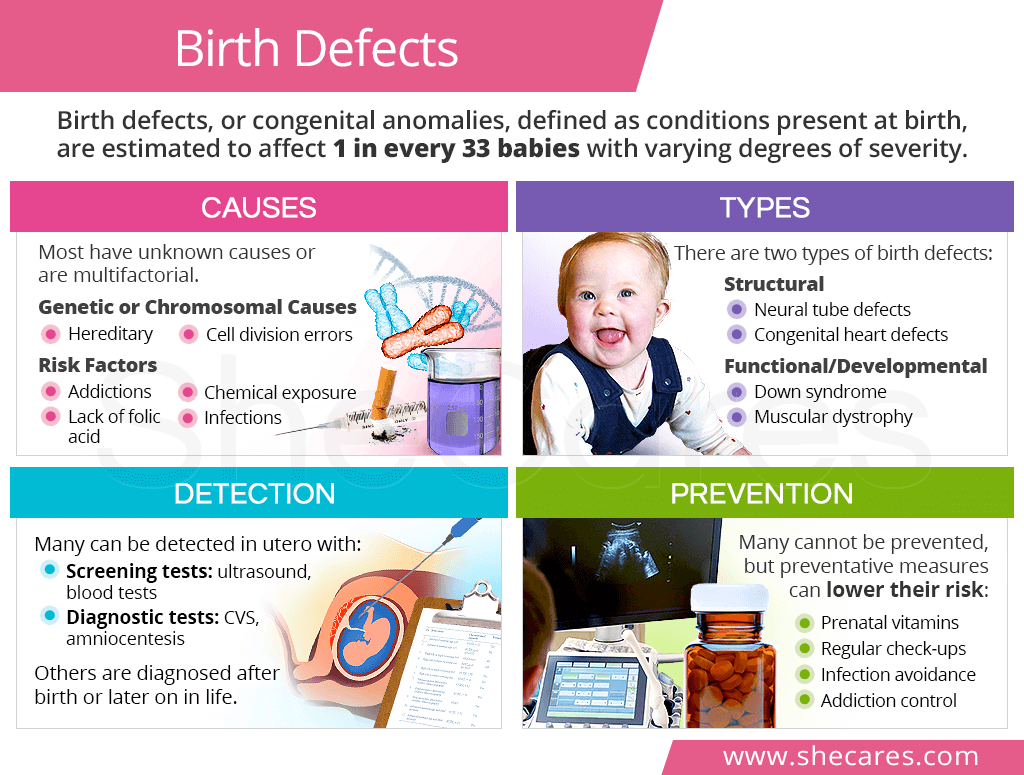Congenital anomalies birth defects can be defined as structural or functional anomalies eg. The cause of congenital hand anomalies is unknown.

World Birth Defects Day Africa Health Organisation
Metabolic defects cause problems with the babys body chemistry.

Most common cause of congenital anomalies. Suicidal ideation refers to thinking about considering or planning suicide. The disabilities can range from mild to severe. The risk factors of congenital birth defects include genetics socioeconomic or demographic factors environment infection and a mothers nutrition.
Symptoms can vary from none to life-threatening. While the prostate may indeed be a source of pelvic pain it is likely that in many cases that pain in the male pelvis does not stem entirely or in some cases at all from issues with the prostate itself. Congenital anomalies are the major cause of new born deaths.
It affects boys and girls equally. A congenital heart defect is classed as a cardiovascular disease. Congenital anomalies can be further subdivided into benign or pathologic.
Depending on the type and extent of a hand malformation some babies may have little trouble adapting and functioning well. The majority of bilateral congenital or infantile cataracts not associated with a syndrome have no identifiable cause. Stenosis contracture of the external opening meatus is the most common but congenital stricture of the urethra occasionally occurs at other points.
Optic nerve anomalies can be categorized as congenital or acquired. Polydactyly is the most common congenital hand deformity. Structural disorders in which problems are seen with the shape of a body part and functional.
Birth defects are also known as congenital abnormalities congenital disorders or congenital malformations. Metabolic disorders that occur during intrauterine life and can be identified prenatally at birth or later in lifeCongenital anomalies are also known as birth defects congenital disorders or congenital malformations. Valves or flaps across the anterior or posterior part of the urethra may cause congenital urethral obstruction in males.
Down syndrome which causes delay in physical and. Over fifteen genes involved in cataract formation have been identified and the inheritance is most often autosomal dominant although it can be X-linked or autosomal recessive. Renal and hepatobiliary cysts laterality defect situs inversus polydactyly agenesis of corpus callosum cognitive impairment retinal degeneration posterior fossa defects or encephalocele skeletal anomalies and obesity.
Suicide is defined as death caused by self-directed injurious behavior with intent to die as a result of the behavior. Birth defects are divided into two main types. Others however may face various challenges as they grow and learn.
A birth defect also known as a congenital disorder is a condition present at birth regardless of its cause. The most common types of functional or developmental birth defects include. The most common syndromes.
They can cause lifelong disability or death. Birth defects may result in disabilities that may be physical intellectual or developmental. Prostatitis is the most common urologic diagnosis in men younger than 50.
A suicide attempt is a non-fatal self-directed potentially injurious behavior with intent to die as a result of the behaviorA suicide attempt might not result in injury. Identifying the exact cause of a congenital birth defect can be difficult since one. They are the most common type of birth defect affecting nearly 40000 births in the United States each year.
Acquired abnormalities are assumed to be pathologic and generally are described with respect to optic nerves reaction to a given insult ie cupping swelling or atrophy. They can be defined as structural or functional anomalies for example metabolic disorders that occur during intrauterine life and can be identified prenatally at birth or sometimes may only be detected later in infancy such as hearing defects. There are several common features in syndromes associated with nonmotile ciliopathies.
Malformations of the limbs or vertebral column were the most common anomalies and accounted for 33 of all associated defects. A congenital heart defect CHD also known as a congenital heart anomaly and congenital heart disease is a defect in the structure of the heart or great vessels that is present at birth. Genetic mutation is likely the most common cause.
There is a considerable variety of urethral anomalies. 15 of all associated malformations were multiple and they were. Congenital heart defects are conditions present at birth that can affect the way the heart works.
Congenital heart defects are the most common type of birth disorders in the United States affecting nearly 1 percent of the annual births in the country according to the Centers for Disease. Signs and symptoms depend on the specific type of defect. 24 of associated malformations were of the cardiovascular system and congenital heart disease was the most common isolated associated malformation.

1 Etiologic Classification Of Congenital Malformations Download Table

The Newborn At Risk Acquired And Congenital Conditions Ppt Download

System Wise Distribution Of Congenital Anomalies N 286 Download Scientific Diagram

Congenital Disorders Clinical Practice Osmosis

Anesthetic Implications Of Common Congenital Anomalies Anesthesiology Clinics

System Wise Distribution Of Congenital Anomalies N 286 Download Scientific Diagram

Types Of Congenital Anomalies Of The Urinary Tract Diagnosed Download Scientific Diagram

Causes Of Congenital Abnormalities Download Table
